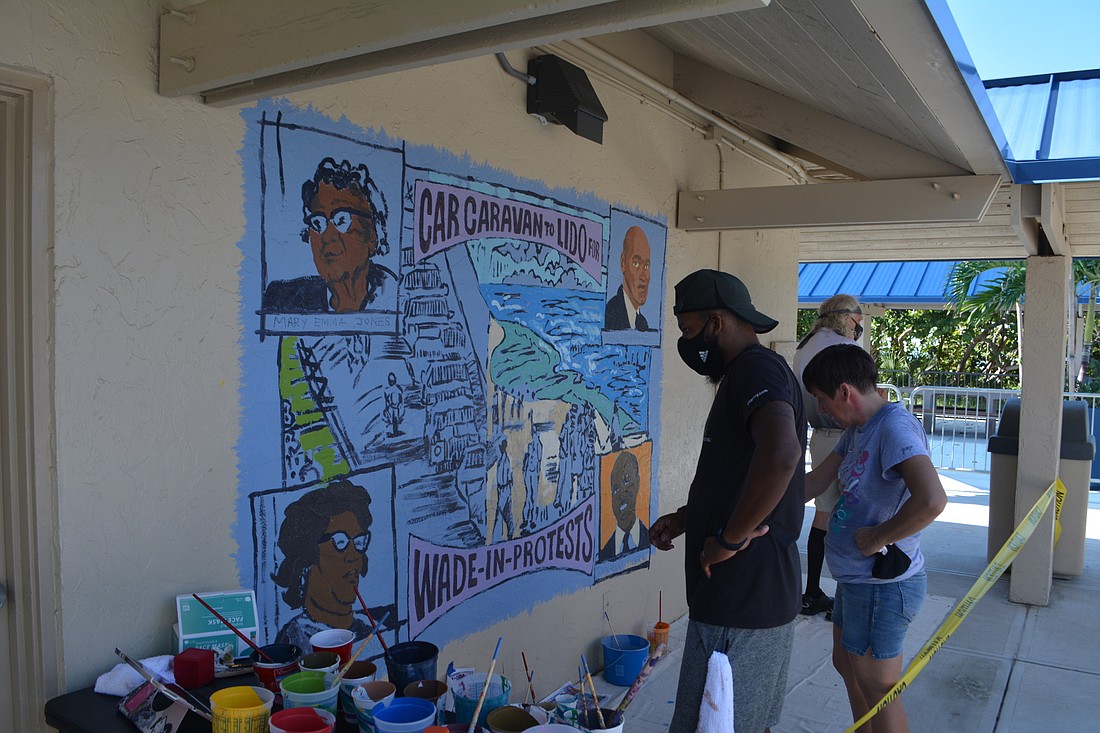- January 4, 2025
-
-
Loading

Loading

When the city’s work to refurbish the Lido Beach pavilion is complete in early 2021, a new concession area and bathrooms won’t be the only additions to the property.
On Saturday, led by artists from Ringling College of Art and Design, a group of Sarasota residents helped paint two murals on the exterior of the pavilion building. Designed by artist Tim Jaeger, both murals paid honor to Lido Beach history.
One mural depicts the wade-in protests of the 1950s and 1960s as Black residents fought to desegregate Sarasota’s beaches. The second showcases the Lido Casino, a beach centerpiece from 1940 through the 1960s that predated the pavilion and featured space for swimming, dining, drinking, shopping and more.
The murals are the product of collaboration between multiple groups, including the Arts and Cultural Alliance of Sarasota County, Newtown Alive, Visit Sarasota County and the city of Sarasota. Jaeger said a conversation about a mural program for Lido Key began about six months ago, with a committee working to identify key historical figures, structures and events that the artwork could showcase.
Jim Shirley, executive director of the Arts Alliance, said Sarasota City Manager Tom Barwin had reached out to express interest in a mural program following the onset of the COVID-19 epidemic. With Sarasota’s arts community affected by the economic downturn, Barwin and Shirley both wanted to move quickly to get murals up — both to create opportunities for work and to inject some energy into the city.
“We didn’t want to do something two years from now,” Shirley said. “The community needs some uplift right now. Artists need income right now.”
Vickie Oldham, founder of Newtown Alive, credited Walter Gilbert with bringing the idea for murals to the group. Oldham said she wanted to find opportunities for spin-off projects that complemented Newtown Alive’s work documenting the history of Sarasota’s African American community.
Oldham, Gilbert and former Sarasota Mayor Fredd Atkins were in attendance Saturday as the murals went up on the pavilion walls. Atkins said it was important to see the fight for desegregation represented in artwork showcasing the history of Lido Key.
“It’s part of a continuum of identifying our history as part of Sarasota’s history,” Atkins said. “A lot of the time, the African American community gets left out of the history of Sarasota.”
Atkins, Oldham and Gilbert all emphasized the significance of having the mural located on the beach, in one of the most heavily trafficked places in Sarasota.
“We could have put a mural like this in Newtown and it wouldn’t have spoken as loudly and as often,” Atkins said.
Jaeger said the committee had identified ten different historical subjects that could be featured in the paintings, and he was hopeful resources would be available to add more murals to the pavilion. He was hopeful the intersection of art and history in a high-profile location would spark the curiosity and attention of beachgoers on Lido.
“The goal is to make art work so people learn from it and walk away with a greater understanding of our history,” Jaeger said.